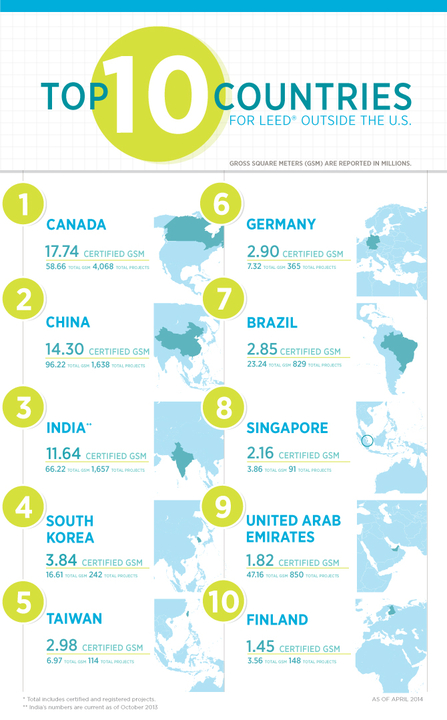- Canada: 100 Wellington Street West Tower at the Dominion Centre in Toronto, LEED Platinum, the first project in the city to achieve Platinum certification under LEED for Existing Buildings: Operations & Maintenance
- China: Haworth Showroom in the Parkview Green in Beijing, LEED Gold, the first project to certify under LEED v4, the latest version of LEED
- India: ITC Maurya Hotel in New Delhi, built in 1977, Platinum under LEED for Existing Buildings: Operations & Maintenance
- South Korea: Samsung GREEN TOMORROW, the first LEED Platinum project in East Asia
- Taiwan: Taipei 101, one of the tallest buildings in the world, LEED Platinum under LEED for Existing Buildings: Operations & Maintenance
- Germany: MesseTurm in Frankfurt, an iconic 63-story skyscraper and one of the tallest in Europe, LEED Silver
- Brazil: Castelao Arena in Fortaleza, the first 2014 World Cup stadium to earn LEED certification
- Singapore: Asia Square Tower 1, a 43-story office building, LEED Platinum
- United Arab Emirates: Dubai Electricity and Water Authority Headquarters, LEED Platinum
- Finland: Sello shopping center, the first European shopping mall to receive LEED Gold
Related Stories
| Aug 11, 2010
Balfour Beatty agrees to acquire Parsons Brinckerhoff for $626 million
Balfour Beatty, the international engineering, construction, investment and services group, has agreed to acquire Parsons Brinckerhoff for $626 million. Balfour Beatty executives believe the merger will be a major step forward in accomplishing a number of Balfour Beatty’s objectives, including establishing a global professional services business of scale, creating a leading position in U.S. civil infrastructure, particularly in the transportation sector, and enhancing its global reach.
| Aug 11, 2010
Construction unemployment rises to 17.1% as another 64,000 construction workers are laid off in September
The national unemployment rate for the construction industry rose to 17.1 percent as another 64,000 construction workers lost their jobs in September, according to an analysis of new employment data released today. With 80 percent of layoffs occurring in nonresidential construction, Ken Simonson, chief economist for the Associated General Contractors of America, said the decline in nonresidential construction has eclipsed housing’s problems.
| Aug 11, 2010
Billings at U.S. architecture firms exceeds $40 billion annually
In the three-year period leading up to the current recession, gross billings at U.S. architecture firms increased nearly $16 billion from 2005 and totaled $44.3 billion in 2008. This equates to 54 percent growth over the three-year period with annual growth of about 16 percent. These findings are from the American Institute of Architects (AIA) Business of Architecture: AIA Survey Report on Firm Characteristics.
| Aug 11, 2010
CHPS debuts high-performance building products database
The Collaborative for High Performance Schools (CHPS) made a new tool available to product manufacturers to help customers identify building products that contribute to sustainable, healthy, built environments. The tool is an online, searchable database where manufacturers can list products that have met certain environmental or health standards ranging from recycled content to materials that contribute to improved indoor air quality.
| Aug 11, 2010
ICC launches green construction code initiative for commercial buildings
The International Code Council has launched its International Green Construction Code (IGCC) initiative, which will aim to reduce energy usage and the carbon footprint of commercial buildings.Entitled “IGCC: Safe and Sustainable By the Book,” the initiative is committed to develop a model code focused on new and existing commercial buildings. It will focus on building design and performance.
| Aug 11, 2010
Green Building Initiative launches two certification programs for green building professionals
The Green Building Initiative® (GBI), one of the nation’s leading green building organizations and exclusive provider of the Green Globes green building certification in the United States, today announced the availability of two new personnel certification programs for green building practitioners: Green Globes Professional (GGP) and Green Globes Assessor (GGA).
| Aug 11, 2010
Potomac Valley Brick launches brick design competition with $10,000 grand prize
Potomac Valley Brick presents Brick-stainable: Re-Thinking Brick a design competition seeking integrative solutions for a building using clay masonry units (brick) as a primary material.







